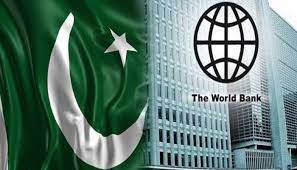Web Desk
The World Bank has kept Pakistan’s economic growth forecast for the current fiscal year unchanged at 3.4%, which is lower than the official target and the second sluggish pace in South Asia amid a rapid increase in inflation.
The bank on Tuesday released the latest Global Economic Prospects report 2022, which projected that both the advanced and developing economies would further slow down after showing recoveries last year.
In the report, the World Bank maintained a 3.4% growth rate for Pakistan for fiscal year 2021-22 that would end in June this year. The number is similar to what the bank projected in its October 2021 publication – the South Asia Economic Focus.
The federal government has set a 4.8% gross domestic product (GDP) growth target for the current fiscal year, although in its monthly publication the finance ministry projected that the growth will remain above 5%.
Last week, the Prime Minister’s Economic Strategy Group predicted a 4.5% economic growth rate for the current fiscal year.
The Pakistan Institute of Development Economics (PIDE) has said that the country needs to grow at an annual pace of 7% to 9% for a few decades to absorb the youth bulge.
Over 31% of the youth with degrees, including the professional ones, are unemployed with females at 51% and males at 16%, according to a paper jointly written by Dr Nadeemul Haque and Durr-e-Nayab. Rural graduate unemployment is much higher than the urban graduate unemployment.
The paper underlined that the sub-optimal nature of employment for those employed could be gauged from the fact that 23% of the labour force was involved in unpaid labour, 13% of males and a huge 57% of the employed females.
Thus, unpaid labour is prevalent across all industries in both rural and urban areas.
The Pakistan Bureau of Statistics (PBS) last week reported 12.3% inflation rate for December, which the PM’s Economic Strategy Group was told would exceed 13% in January.
The low economic growth rate coupled with high inflation and high unemployment suggests that Pakistan is passing through a phase of stagflation.
The global lender once again estimated last fiscal year’s growth at 3.5%, while showing reluctance to accept last fiscal year’s 4% growth rate.
“Growth in Pakistan surprised on the upside last year supported by improving domestic demand, record high remittance inflows, a narrow targeting of lockdowns and accommodative monetary policy – real interest rates dropped precipitously during 2020 and remained negative throughout most of 2021,” said the World Bank.
The 3.4% growth rate was the second lowest in the South Asian region and was only above the 2.1% growth projected for Sri Lanka, which was also facing external sector problems.
Maldives economy has been projected to grow at the fastest pace of 11%, followed by 8.7% for India, 6.4% for Bangladesh, 5.4% for Bhutan and 3.9% for Nepal, according to the report.
The bank said that following a strong rebound in 2021, the global economy is entering a pronounced slowdown amid fresh threats from Covid-19 variants and a rise in inflation, debt and income inequality that could endanger the recovery in emerging and developing economies.
Global growth is expected to decelerate markedly from 5.5% in 2021 to 4.1% in 2022 and 3.2% in 2023 as pent-up demand dissipates and as fiscal and monetary support is unwound across the world, it added.
The slowdown will coincide with a widening divergence in growth rates between advanced economies and emerging and developing economies.
Growth in advanced economies is expected to decline from 5% in 2021 to 3.8% in 2022 and 2.3% in 2023 – a pace that, while moderating, will be sufficient to restore output and investment to their pre-pandemic trend in these economies.
In emerging and developing economies, however, growth is expected to drop from 6.3% in 2021 to 4.6% in 2022 and 4.4% in 2023. By 2023, all advanced economies will have achieved a full output recovery; yet output in emerging and developing economies will remain 4% below its pre-pandemic trend, according to the World Bank















